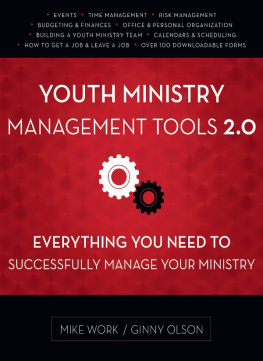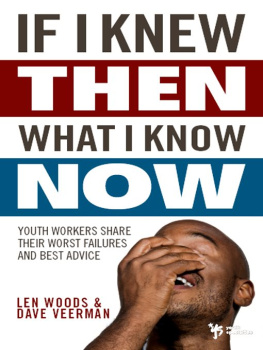
ZONDERVAN
Youth Ministry Management Tools 2.0
Copyright 2014 by Ginny L. Olson and Michael A. Work
YS Youth Specialties is a trademark of Real Resources Incorporated and is registered with the United States Patent and Trademark Office.
ePub Edition August 2014: ISBN 978-0-310-51686-6
Requests for information should be addressed to:
Zondervan, 3900 Sparks Dr. SE, Grand Rapids, Michigan 49546
Library of Congress Cataloging-in-Publication Data
Work, Mike, 1961
Youth ministry management tools 2.0 : everything you need to successfully manage your ministry / Mike Work and Ginny Olson.
pages cm
ISBN 978-0-310-51685-9
1. Church work with youth. I. Title.
BV4447.W6685 2014
259.23dc23
2014009126
All Scripture quotations, unless otherwise indicated, are taken from The Holy Bible, New International Version, NIV. Copyright 1973, 1978, 1984, 2011 by Biblica, Inc. Used by permission. All rights reserved worldwide.
Any Internet addresses (websites, blogs, etc.) and telephone numbers in this book are offered as a resource. They are not intended in any way to be or imply an endorsement by Zondervan, nor does Zondervan vouch for the content of these sites and numbers for the life of this book.
All rights reserved. No part of this publication may be reproduced, stored in a retrieval system, or transmitted in any form or by any meanselectronic, mechanical, photocopy, recording, or any otherexcept for brief quotations in printed reviews, without the prior permission of the publisher.
Cover design: Lucas Art and Design
Interior design: Matthew Van Zomeren
CONTENTS
A vision without a task is but a dream,
A task without a vision is drudgery
A vision with a task is the hope of the world.
Church Window in Sussex England, c. 1730
M any of us in youth ministry share a vision: Tribes of adolescents encountering God, families healed, churches reenergized, communities rolling up their sleeves and serving each other. But since were usually mired in a bog of details surrounding those dreams, our vision can get cloudyor slowly dissipate altogether.
One of our goals in writing this book was to help youth workers to get out of the bog and back on track with their vision. Those who are merely ankle deep in the muck can discover here fresh ideas and variations on old practices. Those who sense theyre sinking fast can find a lifeline in Youth Ministry Management Tools 2.0. This book will help youth workers do more than merely survive the tasks of ministryit will show you how crucial those tasks are for accomplishing your vision.
Our vision as developers is to help you succeed in all facets of youth ministry management. Our task as authors was to write a book to facilitate that success. We hope God will use our vision and our task to impact adolescents and their families for the kingdom through your work and your skills.
Interact with this book. Read the narrative, underline it, dog-ear it, scan it, slap sticky notes on it. Play with the forms. Get your team to wrestle with the case studies. Ask, How can I use this stuff? How can it help our ministry run better and more smoothly? What do I need to do because of what Im reading? Gobble it all up or nibble at it a piece at a time.
Rookie youth workers will find ideas in Youth Ministry Management Tools 2.0 for handling tasks that are basic to long-term youth ministry. There are case studies to get you thinking, forms you can adapt and tweak, and checklists to help you anticipate and track details of ministry.
Youth workers who are less structured (read: disorganization is my middle name) will find systems, methods, and forms that are easily adaptable to your needs. No more developing procedures from scratch.
Veteran youth workers can use this book as a tool to train interns or key volunteers, as a resource manual to dip into periodically, and a storehouse to supplement (perhaps even re-approach) your already effective ministry practices.
Having an organized ministry is important and will actually help broaden your reach and impact. But at the end of the day this is all about the teenagers God has entrusted to you. We dont think for a moment that organizing is the goal. Loving and caring for teens is the goal.
CAVEATS AND WARNINGS
Weve done our best to make sure everything is accurate, but this book is not to be taken as legal counsel. Run critical decisions, policies, and forms by your church or organizations lawyer and insurance company.
Throughout the book we reference resources and products. These are not endorsements but rather tools and sites weve found helpful. Were sure weve missed a number of great ideas and resources. Let us know what they are and well include them in future editions.
HAVING TROUBLE WITH A WEB ADDRESS?
Internet addresses listed in this book were current at the time of publicationbut theres no way we can guarantee these addresses are current as you read these words. But well do our best to keep them updated at ministrymanagement.com. If you have trouble with an URL and the correction isnt posted on the previously mentioned Web site, please contact us via email (ymmt.ginny@gmail.com) to let us know if youve found the correct or new URLor if the URL is no longer operational.

CHAPTER OVERVIEW
O ne of the very first things we learn about God is God is both creative and administrative. In the beginning of Genesis, God creates the heavens and the earth. God then goes on to separate darkness and light, water, and ground, and categorizes the animals. A calendar of seven days is set, including a day of rest. From the get-go, we see a mix of creativity and organization. We also see God giving pastoral care in interactions with Adam about his loneliness. Early on God institutes policies (e.g., dont eat the fruit from the tree in the middle of the garden) not for the sake of policy but for the protection of people and the pursuit of Gods purposes.
From the beginning we see that God desires us to be relational, creative, organized, and purposeful. God had a plan and set the desired course for creation. Yet we youth workers spend a lot of time making decisions that we hope are moving us forward on our desired course.
If you ask a group of people in a windowless room to close their eyes and spin around and then point north, when they open their eyes, they will be pointing in every direction. Some will be pointing in the right direction; others, not so much. This is a fairly accurate representation of how some youth workers lead: theyre spinning around, trying to move in a direction they believe to be north, but often theyre without tools to navigate. The result is that they may or may not make it to their destination. By placing one foot in front of the other with no sense of direction, its possible to get miles off course. A philosophy of ministry and a philosophy of leadership provide those inner compasses to direct a leader and his or her followers to true north.
The most effective youth workers understand why they do what they do. And they can articulate it to others. What is your philosophy of youth ministry? is the one interview question that often stumps those who havent done the hard work of formulating their philosophies of ministry and leadership.
Theres no formula for developing a ministry philosophy, but there are some areas to consider. Based loosely on the work of educational philosopher William Frankena, the following components can help you clarify what you believe about ministry and how it should be lived out. Understand that there are whole seminary courses about philosophy of youth ministry. This is just a primer to get you started:
Next page














